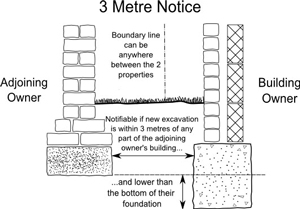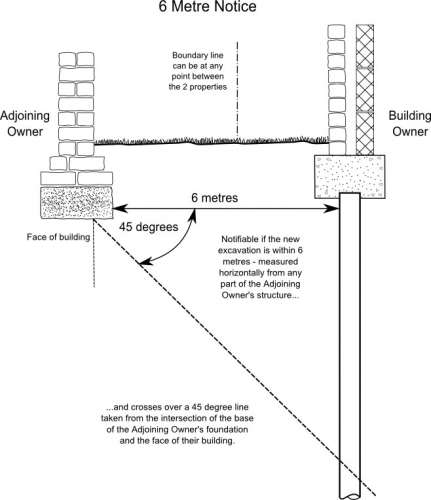We thought it would be useful to have a single article summarising all works which come within the scope of the Party Wall etc. Act 1996 and therefore require a notice to be served. The focus of this article is alterations and extensions to residential properties.
Notifiable works will fall in to one of three categories.
- Work which has a direct effect on a party structure (or adjoining structure);
- Excavation close to an adjoining owner’s building;
- The construction of a new wall at the line of junction between two properties
1. Work which has a direct effect of a party structure (or adjoining structure).
The list of works which a building owner has the right to undertake that have a direct effect on a party structure (or adjoining structure) are given under section 2(2). I have listed them below with some common examples:
(a) “To underpin, thicken or raise a party structure, a party fence wall, or an external wall which belongs to the building owner and is built against a party structure or party fence wall” – This section allows a Building Owner to increase the height of a party wall, say, as part of a loft conversion or to add an extra floor to a building. The right to underpin the full width of a party wall may need to be exercised if it has suffered from subsidence or if a basement extension is proposed.
(b) “To make good, repair, or demolish and rebuild, a party structure or party fence wall in a case where such work is necessary on account of defect or want of repair of the structure or wall” – Where a party wall has become defective either owner can take the initiative and serve notice to have it repaired or re-built. The costs of the work are split according to the use that the owners make of the wall and responsibility for the defect or lack of repair.
Sub-sections (c) & (d) can be ignored for works to residential properties.
(e) “To demolish a party structure which is of insufficient strength or height for the purposes of any intended building of the building owner and to rebuild it of sufficient strength or height for the said purposes (including rebuilding to a lesser height or thickness where the rebuilt structure is of sufficient strength and height for the purposes of any adjoining owner)” – This right would only be exercised as a last resort as the costs would be considerable; including the payment of compensation to the adjoining owner for disturbance and inconvenience. Most designers/engineers would explore alternative options first such as a steel frame that sits alongside the party wall.
(f) “To cut into a party structure for any purpose (which may be or include the purpose of inserting a damp proof course)” – This right is most commonly exercised by a building owner cutting pockets in to a party wall to insert beams, either as part of loft conversion works or when internal walls are to be removed. It also covers the insertion of flashings and damp-proofing works which involve drilling or cutting in to the party wall.
(g) “To cut away from a party wall, party fence wall, external wall or boundary wall any footing or any projecting chimney breast, jamb or flue, or other projection on or over the land of the building owner in order to erect, raise or underpin any such wall or for any other purpose” – This section covers the demolition of chimney breasts which are attached to a party wall but also gives the building owner the right to cut away other projections from the party wall, such as footings, if they are impeding his building work.
(h) “To cut away or demolish parts of any wall or building of an adjoining owner overhanging the land of the building owner or overhanging a party wall, to the extent that it is necessary to cut away or demolish the parts to enable a vertical wall to be erected or raised against the wall or building of the adjoining owner” – In practice it will be items such as rainwater gutters, soffits and fascias or coping stones which will be in the way of a building owner wanting to raise his wall . The building owner has a duty to make good any damage.
(j) “To cut into the wall of an adjoining owner’s building in order to insert a flashing or other weather-proofing of a wall erected against that wall” – If a building owner constructs an extension alongside an adjoining owner’s existing extension it is likely that a small gap will remain. It would normally be in the interests of both owners to waterproof the gap with a flashing, if that flashing has to be cut in to the adjoining owner’s wall this section gives the building owner the right to do just that.
(k) “To execute any other necessary works incidental to the connection of a party structure with the premises adjoining it” – In practical terms this section is only likely to be used in residential situations where a building owner wants to re-build their property but leave the party wall in place, it may then be necessary to form a more permanent connection between the party wall and the adjoining structure and to attach the new building to the existing party wall.
(l) “To raise a party fence wall, or to raise such a wall for use as a party wall, and to demolish a party fence wall and rebuild it as a party fence wall or as a party wall” – A party fence wall is effectively a garden wall which is in shared ownership – they are commonly found between period properties; particularly those with back additions which have windows to the side. This section gives either owner the right to raise or re-built such a wall as part of a side return extension (the other owner could then make use of the wall if they built a similar extension).
(m) Subject to the provisions of section 11(7), to reduce, or to demolish and rebuild, a party wall or party fence wall to –
(i) a height of not less than two metres where the wall is not used by an adjoining owner
(ii) to any greater extent than a boundary wall; or a height currently enclosed upon by the building of an adjoining owner
This section allows a building owner to reduce the height of a party wall or a shared garden wall down to a height of no less than 2 metres so long as it doesn’t compromise the adjoining owner’s building. If both owners are in agreement a wall can be removed altogether.
(n) “To expose a party wall or party structure hitherto enclosed subject to providing adequate weathering” – The purpose of this section is really to protect an adjoining owner where a building owner plans to remove part or all of their structure and as a result expose the party wall. It may be necessary to protect the newly exposed wall with felt and battens if the exposure is temporary or if it is to be permanently exposed a more permanent solution, such as rendering or re-pointing may be required.
The notice period for works under section 2 of the Act is 2 calendar months.
2. Excavation close to an Adjoining Owner’s Building.
It surprises many building owners that they must serve a notice on their neighbour even though the hole they plan to dig will be entirely on their own land. The reason of course is that excavating close to any structure carries a risk that the foundations to that structure will be compromised and movement will occur.
This type of work is covered by section 6 of the Act and can be divided in to two parts. Below I have given the relevant text from the act together with a sketch which I hope will clarify the description.
Section 6(1), where –
(a) a building owner proposes to excavate, or excavate for and erect a building or structure, within a distance of three metres measured horizontally from any part of a building or structure of an adjoining owner; and
(b) any part of the proposed excavation, building or structure will within those three metres extend to a lower level than the level of the bottom of the foundations of the building or structure of the adjoining owner.

Section 6(2), where –
(a) a building owner proposes to excavate, or excavate for and erect a building or structure, within a distance of six metres measured horizontally from any part of a building or structure of an adjoining owner; and
(b) any part of the proposed excavation, building or structure will within those six metres meet a plane drawn downwards in the direction of the excavation, building or structure of the building owner at an angle of forty-five degrees to the horizontal from the line formed by the intersection of the plane of the level of the bottom of the foundations of the building or structure of the adjoining owner with the plane of the external face of the external wall of the building or structure of the adjoining owner.

The notice period for excavation work which comes within the scope of the Act is 1 calendar month.
3. The construction of a new wall at the line of junction between two properties.
This category covers the construction of new walls at the line of junction i.e. the boundary line between two properties in different ownership. The new wall may be built up to the boundary line but wholly on the land of the building owner or astride the boundary line i.e. with part of it on each owner’s side. If the adjoining owner refuses consent then the wall must be built wholly on the building owner’s side. The construction of new wall at the line of junction are covered under section 1 of the Act.
There are two practical reasons why a Building Owner might want to carry out work detailed under this section of the Act:
1. To maximise the width of a rear extension.
If the flank walls of a new extension can be built astride the boundary then a few extra square feet of internal floor space will be gained. It should be noted that new walls built astride the boundary under this section of the Act will be defined as party walls and may be enclosed upon by the adjoining owner at a later stage (subject to serving notice and contributing towards the cost of building the wall).
2. To replace an existing boundary wall, fence or hedge with a party wall or party fence wall.
This is less common and the motivation will generally be to provide additional privacy or to overcome the maintenance that is required with fences and hedges.
The notice period for building a new wall at the line of junction is 1 calendar month. Procedures differ from works under sections 2 & 6 of the Act in that there is no automatic dissent to a notice after 14 days. If the wall which the building owner wishes to construct is wholly on their own land and they have had no response to their notice after 1 calendar month has passed they are free to proceed.
This article was written by the team at Peter Barry Party Wall Surveyors. If you are in London or the surrounding areas and have a question relating to party wall procedures you can contact them on 020 7183 2578 or by email and receive up to 20 mins free advice.
